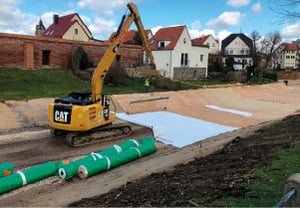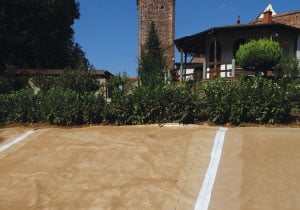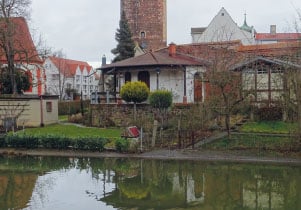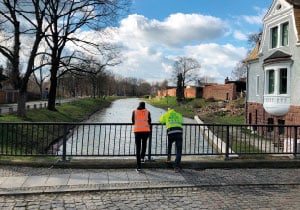Project: Coated geosynthetic clay liners rehabilitate historical moat
Product: Bentofix X5F BFG 5300


Fig. 1: Installation of Bentofix® Fig. 2: Installed GCL Bentofix® X
Challenge
In the shape of a horseshoe, the moat runs around the old town centre of Delitzsch in Saxony. The moat is a standing water body with an old clay liner. The moat can be fed with fresh water from the nearby small river Lober if necessary.
However, the historic moat has lost water for decades and threatens to become marshy. Consequently, the city of Delitzsch decided to rehabilitate and reseal it. Since the moat was to be replanted with reeds known for their proliferating roots, a root-barrier sealing system was required.


Fig. 3: Moat (1st part of construction ) after flooding Fig. 4: Moat after succesful rehabilitation
Solution
The designer selected Bentofix® X, a polyethylene-cated bentonite mat, also known as multi-component geosynthetic clay liner (GCL).
It is used to replace conventional clay liners. In this sealing element, sodium bentonite powder is encapsulated between two geotextile layers using a special needle-punching technology. The result is a hydraulic seal that is directionally independent and transmits shear force over the entire surface. The bentonite swells quickly and creates a homogeneous, gel-like sealing layer in contact with fresh water. In case of Bentofix® X, a polyethylene (PE) coating is additionally extruded onto the woven component layer and thus permanently fixed to the needle-punched fibres. The additional PE coating protects in this application against root penetration and desiccation of the bentonite powder and additionally decreases significantly the barrier ́s hydraulic conductivity. This approximately 10mm thick multi-component GCL has a much higher sealing effect than typically any clay sealing layer.
Consequently, immense transport and installation costs are saved in addition to material costs. The GCL, therefore, also has a significant economic advantage. Approximately 14,000m2 of GCL were installed for the rehabilitation and sealing of the moat.
Since the PE coating of the Bentofix® X5F type also has a rough surface structure, it could also be used in the slope areas. At the same time, the additional PE coating in Delitzsch protects the moat from root penetration and prevents the bentonite from desiccation, especially in the water exchange area. Furthermore, this PE-coated Bentofix® GCL has a significantly lower permeability than, for example, a 1m thick clay layer.
To sufficiently protect against root penetration, the overlap area joints were also sealed with a “Bentofix® X-Tape A”. The butyl-based joint tape was placed centrally on the PE coating of the overlap edge. To achieve optimum contact between the PE coating and the tape, especially under colder weather conditions, the surface was heated with a hot-air gun, and the tape was then firmly pressed down with the pressure roller. The pressure ensures that the tape “sticks” well, even in the coating structure.
The sealing system of the moat was designed as follows (from top to bottom):
- approx. 40cm of soil confining stress consisting of large-stone-free material, kf value 10-7 m/s
Multicomponent GCL (incl. joint sealing with Bentofix® X-Tape A)
20 - 30cm drainable crushed stone - grain size 2 - 16mm
The first construction section between Hallescher Turm (Halle Tower) and Leipziger Straße has a distance of approx. 400 metres. The 2nd construction section between Leipziger Straße and Holzstraße, completed in 2020, covered a total length of approx. 250 metres.
Thus, within a short period, the rehabilitation of the moat could effectively and economically be carried out with the help of the PE-coated GCL Bentofix® X.

